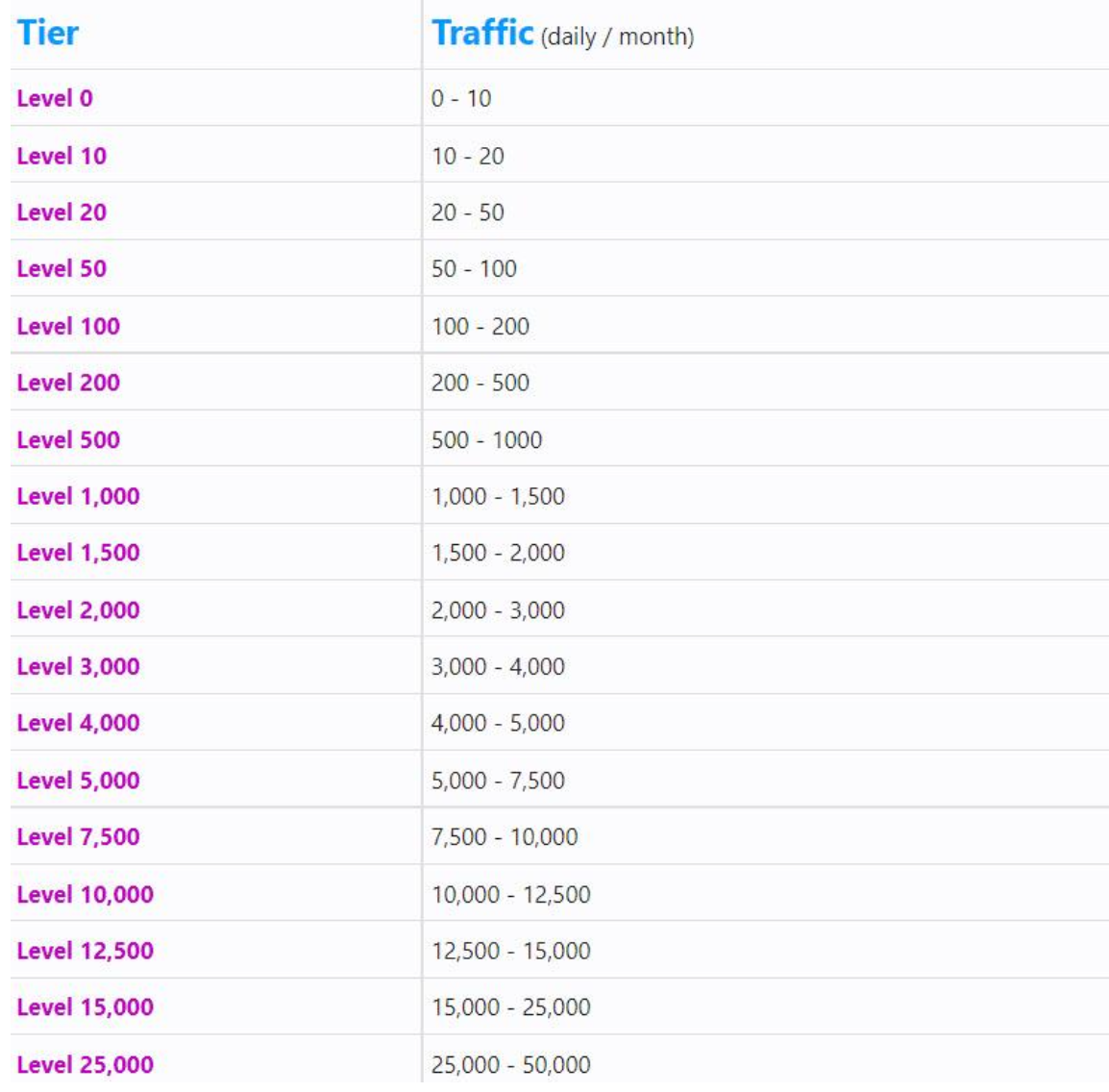Keyword research is the premise of my SEO campaigns. From finding keywords for niches to build sites from scratch in, all the way to stealing my own competitor’s success.
There are an abundance of keyword research guides out there, using variations of old or linear tactics. As well as an overwhelming number of tools, all showing different figures and metrics to make it even more confusing.
In this eBook, I hope to show you the history of keyword research, the most up to date methodology, the best tools on the market (both free & paid) and how you can extract, compile and filter for the best actionable data possible.
It doesn’t matter if you’re doing keyword research for an ECommerce site or a local business, this article can be adapted to any SEO looking to rank a site (or property) in Google.
I am also very aware that people are at different resource levels when it comes to budgets, and some of the more advanced tools can run into the hundreds of dollars per month. I’ve tried to give everyone a variety of options at every price range, but will be honest with which tools are best for which specific tasks – Don’t worry if you can’t afford it NOW, you can always build it to the best toolkit (like Batman) in the months or years to come.
What Is Traditional Keyword Research?
To understand what constitutes modern keyword research today, we must look at how keyword research was done years back.
This isn’t to say that traditional keyword research no longer works. You can still rank web pages using the methodologies involved in this process, but they’re just not as effective as before.
By discussing the traditional approach, more experienced SEOs will quickly learn if their tactics are outdated as well.
Identify Low-Hanging Fruit Keywords
A low-hanging fruit keyword is typified by having a relatively high search volume and low competition.
Regarding search volume, there is no tangible value that qualifies as “high” since it depends on the niche and industry of your website. Popular niches have keywords with hundreds and thousands of monthly searches. The monthly searches of a niche’s main keywords dwindle as the niche decreases in popularity.
On the other hand, low competition is identified by its keyword difficulty (KD). The higher the value, the less desirable the keyword becomes due to its stiff competition.
Most SEO tools have a feature to find the KD in a few clicks. Using Ahrefs, for example, click on the Keyword Explorer, type in the keyword, and you can see the KD of that search term. You can even expand your search by looking at keywords related to your initial search and checking their respective KDs.
This simple process has been common practice among SEOs through the years. However, “low-hanging fruit” isn’t as straightforward as it seems.
For one, different SEO tools use different data sets to provide you with actionable insights for your keyword research. Ahrefs is one of the most popular tools out there because it has the largest keyword and backlink database compared to others with over 11.7 billion keywords across ten search engines and 229 countries as of writing. For comparison’s sake, SEMrush has 300 million keywords from over 120 databases.
Therefore, if there’s not enough data about your search queries, it may not produce the data you need for the metrics.
Second, each tool computes the KD of a keyword differently. While the KD score may be similar, don’t expect the score for the same keyword to be the same across different SEO tools.
Running the same keyword above, here is its KD according to SEMrush:
There is a slight difference in the KD and the local search volume, but they are not far off each other.
Now, compare the keyword data from SEO tool SE Ranking:
While SE Ranking produced lower KD than Ahrefs and SEMrush, does that mean the two latter tools are better keyword tools? To an extent, yes, but this brings us to the last point:
Researching for low-hanging fruit keywords forces people to depend on metrics that tools show you. As a result, critical thinking is removed from the equation as people start focusing on variables like KD, Domain Rating (DR), and the like.
Here’s the thing: even if Ahrefs is the most popular choice among SEOs, it can only provide you with an estimation of a keyword’s data.
These tools can amass as much data as they can. But as long as they don’t know the exact way Google ranks pages for a keyword, even the best tools can only offer you the closest approximation for information about a keyword. We’ll talk about this more once we tackle zero search volume keywords.
As you can see, you can’t put your blind faith in keyword tools for your research as they can only provide you with so much data. While tools can help speed up the research process, you must put some thought into finding these keywords and discern which ones you should optimize for your website.
Optimize For Long Tail Keywords
The perfect embodiment of a “low-hanging fruit” keyword is long-tail keywords.
A long-tail keyword contains at least three or more words that are specific, according to industry experts. In fact, the more words the keyword has, the more straightforward it is.
“Specific” is what makes long-tail keywords vital to your SEO strategy. When optimizing your web pages for keywords, you need to target keywords that answer the question, “what do people want to find in a page when searching for this keyword on Google.”
For example, “dog” as a search query is vague and doesn’t provide publishers such as yourself with enough information about what to do about the page optimized for “dog.” As a result, you’ll probably have to talk about everything about dogs, which could span tens and thousands of words.
To help narrow down their search, users add qualifiers to their search query. In this case, “guard dog” should provide you with more precise information about what pages users want to see for this keyword. At the very least, it’s not just about dogs in general, but a particular type of dog.
However, the keyword is still broad to optimize in your content. “Guard dog” may require you to discuss big and small guard dogs, the best guard dogs for families and first-time owners, and others.
Again, you’ll be forced to cover as much ground as possible about guard dogs simply because the search query isn’t specific enough.
This is where long-tail keywords come in. They are search queries narrowed down to a particular subtopic within a subtopic.
In the example above, “best breed of guard dog for families with children” is as narrowed-down as they come. You’ll be hard-pressed to find a similar keyword that’s more specific than this one.
When optimizing for this content, you’ll simply have to mention the best breed and explain why, which is precisely the question users are asking when typing in this keyword.
The only caveat of long-tail keywords is their low search volume. Due to the precise nature of the query, you can expect that only a few users will be searching for this query. Here is its search volume on Ahrefs:
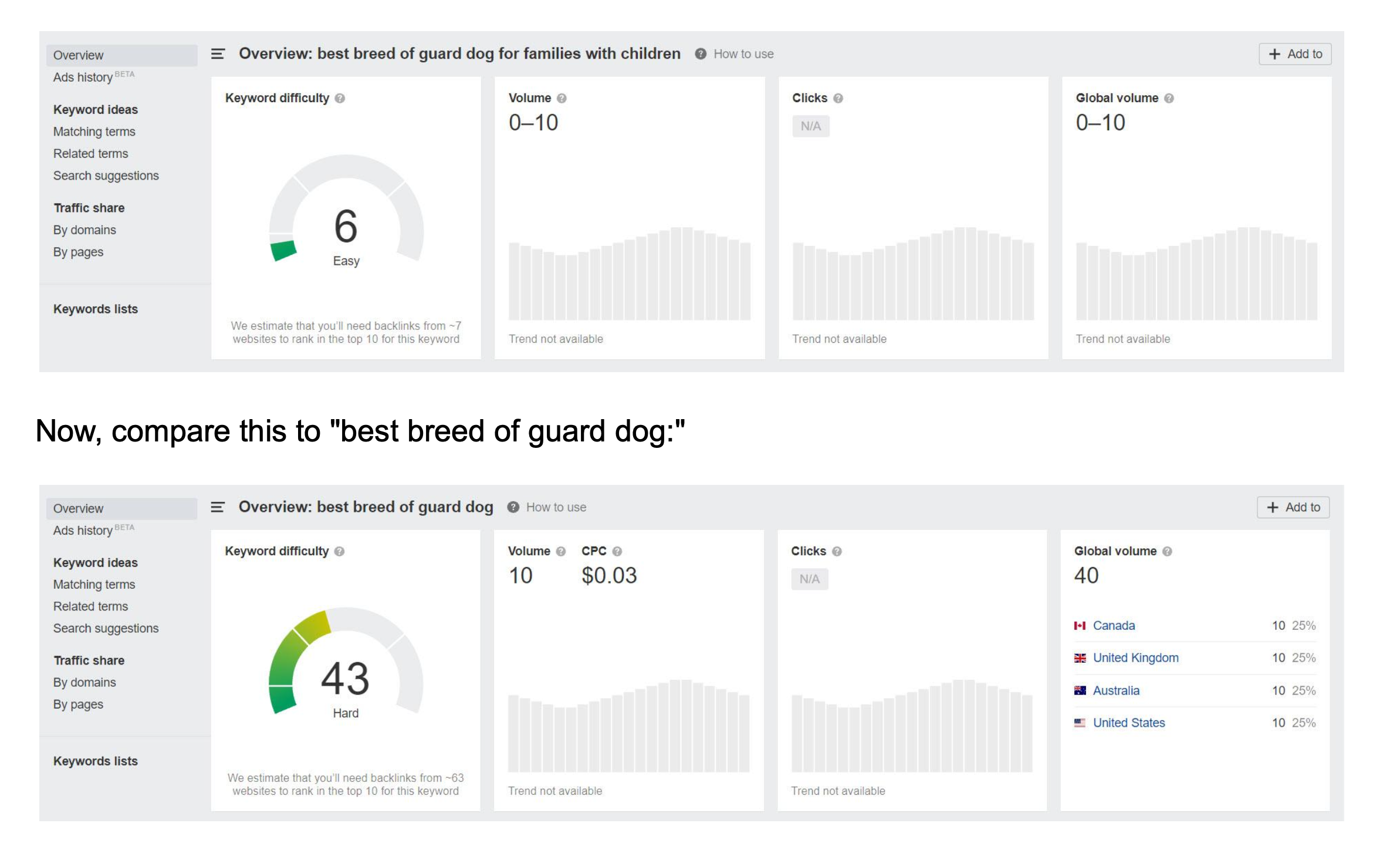
Both are long-tail keywords, but the first one is much more specific than the second one. Therefore, the first one has fewer monthly searches, if not non-existent.
In this case, the solution to this problem is to optimize for as many long-tail keywords as possible. By covering as much ground about a topic with this keyword type, you can build traffic incrementally from the content you’ve created, which should amount to thousands of organic traffic down the line if done correctly.
[web_stories title=”false” excerpt=”false” author=”false” date=”false” archive_link=”true” archive_link_label=”” circle_size=”150″ sharp_corners=”false” image_alignment=”left” number_of_columns=”1″ number_of_stories=”5″ order=”DESC” orderby=”post_title” view=”circles” /]
However, the biggest issue that long-tail keywords present is that site owners focus on optimizing one keyword per page. By putting too much emphasis on specific keywords, people keep chasing the tail. In other words, they search for keywords that’ll bring them traffic over time instead of approaching keyword research topically.
For example, it’s possible to exhaust long-tail keywords about a subtopic. But instead of focusing on much broader keywords about the same topic, some people pivot to long-tail keywords about a different matter. As a result, they cannot build upon the topic relevance necessary for helping your website rank on top of organic search.
We’ll discuss how modern keyword research has replaced this approach by researching and optimizing for keywords on a topical level.
Creating Skyscraper Content
Just as crucial as the researched keywords are what you intend on doing with them.
Of course, you’re supposed to create content optimized for each one. However, you must take this approach on a different level as it’s expected that your competitors will do the same.
This is what Brian Dean did with the type of content he coined “Skyscraper Technique.”
The technique isn’t anything new up to that point, which Brian covered here in great depth. It is essentially creating content that’s much better than your best competitors.
However, Brian dangled the content created using the Skyscraper Technique as linkbait to generate backlinks and help push the page’s ranking on top of organic search for its keyword.
Here’s a general overview of the Skyscraper Technique:
- ● Find link-worthy content – Find content that has the most backlinks for your target keywords using Ahrefs.
- ● Make something even better – Recreate the same content on your website but add more information, provide better examples, and feature rich media — anything that can make your content stand out from the rest.
- ● Reach out to other people – Email people asking them to link to your much better content.Again, while this technique encompasses keyword research, it nonetheless plays a vital role in the success of your campaign. Choosing the right keyword will help trigger a domino effect to your content if everything falls in your favor.
However, while the technique was massively popular for some time and lots of people found success with this approach, it also has some flaws.
For one, the technique does not apply to all industries and niches. If the top content on your niche has few to no backlinks at all, then you’re better off using a different approach in your keyword research and content creation.
Also, bigger doesn’t always mean better. Just because you’re creating “much better” content than your competitors, it doesn’t follow that you’ll get backlinks from your outreach campaign, let alone rank on top of Google.
As mentioned, some factors need to play in your favor for this technique to work. Aside from being in the correct niche, you should also have brand equity to help convince bloggers to replace your competitor’s link with yours.
At the same time, the content should answer the question posed by the search query. Going back to “best breed of guard dog for families with children,” you can’t talk about the history of dogs just to pad your content with information, no matter how irrelevant they are.
Ultimately, while Skyscraper Technique has a place in your SEO strategy, it’s rooted deep into the traditional keyword research approach that its effectiveness has decreased over time. Instead of researching for keywords to create one-and-off content for your site, you need to develop a strategy that gives all the keywords you’ll research and the content you’ll create and publish with a greater sense of purpose in the grand scheme of things.
Why Move To Modern Keyword Research?
To reiterate, traditional keyword research still works to a degree. These aren’t tactics that you should abandon altogether because they still make sense under the right circumstances.
However, if you’re expecting to achieve the results of those who leveraged these tactics years ago, you’re out of luck.
The paradigm shift away from traditional keyword research is due to the fundamental changes with Google.
It has changed that ranking for keywords isn’t as simple as adding your keyword at the right places in your content.
As mentioned above, building topical relevance allows you to create website authority not by targeting keywords but for topics.
Let’s put it this way: if you’re going to create a website about guard dogs, make sure to create informative content that shines a light on this type of dog. Research for keywords and publishing content not about guard dogs dilutes the site’s relevance for the topic.
Aside from the algorithm changes through the years, keyword research is shaped by Google’s ability to read contextual information and provide users with the correct details.
Knowledge Graph
The Knowledge Graph released in 2012 laid the groundwork for how people should approach SEO as a practice. Living by the saying “things, not strings,” Google can provide users with search results relevant to their query even if the question itself can mean many things.
For example, if you searched for “the rock,” Google knows whether you’re looking for information about Dwayne Johnson’s former wrestling name, the 1995 movie starting Sean Connery and Nicholas Cage, or the naturally forming minerals.
The search results provide more than enough information to help you find what you’re looking for in a few clicks.
Concerning optimizing your website, optimizing for a keyword per post is a thing of the year that started around 2012. As mentioned, it’s possible for a page to rank for as many keywords s as it can. Therefore, you must look at the bigger picture and consider opportunities for ranking to other relevant keywords.
Most search rankings are determined by achieving a healthy balance of great content and backlinks. However, other signals have been added through the years, such as mobile-first indexing, loading speed, and the like.
RankBrain
In 2015, Google RankBrain was introduced to the public. It is the search engine’s machine-learning artificial intelligence system that helps Google process results.
It is not a deciding factor that ultimately determines which pages rank for which keywords. Considered the “third-most important signal,” according to a Bloomberg article, it assists Google in interpreting the meaning behind long-tail search queries. It provides users with the best results in conjunction with search features like Knowledge Graph.
RankBrain signals Google’s concerted efforts to understand the relationship among words. Therefore, when you ask Google the age of a public figure or ask when their birthday is, you can get the answer straight from search engine result pages (SERPs) instead of visiting a page from SERPs.
More importantly, Google will continue to provide users with better search results thanks to RankBrain’s machine-learning capabilities. As new words are provided with new usages, Google will eventually pick them up from its AI system.
BERT
In 2019, Google took machine learning to a new level with the Bidirectional Encoder Representations from Transformers or BERT for short.
In a nutshell, BERT involves two processes:
- Evaluate meaning from a context using pre-trained models
- Make sense out of it using the natural language processing (NLP) methodology on search results.
In essence, BERT is the vehicle that makes enriching search results using NLP possible. It is the logical step from RankBrain that primarily focuses on providing better search results for long-tail keywords. Also, RankBrain is only able to connect concepts meaning on a word-level basis.
With NLP via BERT, Google can leverage machine-learning fully by understanding context. It can identify search queries on a more profound understanding using these variables:
- ● Sentiment – determines whether the query is positive, neutral, or negative.
- ● Entity – refers to a word in the page representing an object that can be categorized,classified, and identified.
- ● Salience – measures the importance of the entity on the page.
- ● Category – organizes entities into groups of related entities to form a topic.Google can provide users with more contextual and accurate search results based on the queries you entered using these four variables. In other words, NLP acknowledges the intent of the keyword, which explains to search engines why a user searched for the query.
Inferred Links?
- To recap, below are the changes that Google has undergone to revamp the quality of its search results:
● Knowledge Graph – from strings of characters to things, i.e., entities
● RankBrain – from entities to relationships among entities
● BERT – from relationships among entities to context and intent
Through the different changes, it is evident that Google’s methodology has gotten more and more sophisticated. It can now extract various factors from entities to help users provide much better and contextually relevant search results.
Its advancements on search bring up this particular question:
- Think about it: Google has gotten smarter in determining which pages should appear on SERPs for keywords using the NLP methodology. And with a perpetually learning AI system, its technology can seamlessly carry over to provide users with high-quality search results years to come without skipping a beat.Google’s NLP can be so good that it can use words mentioned on pages as “lexical references that connect topics and keywords to a brand, website, or page.”This is what Rand Fishkin says in his thinkpiece on SparkToro. He hypothesizes that “inferred links” will replace the link graph as a ranking factor.
Instead of building dofollow links from authoritative sites that are “financially-motivated,”
inferred links are more authentic because they’re coming from an unbiased place, at least for now. People who create inferred links unknowingly build them through reviews written on Reddit or Amazon, showing how impartial they are in nature.
Backlinks hold a lot of value as a ranking signal because they serve as recommendations in the eyes of search algorithms. The fact that a website links back to your site means it trusts you enough to refer to you as a resource about a topic.
But as mentioned, most backlinks are motivated by ranking on top of Google search for their keywords. By building more links from high-authority sites, your site also increases in ranking.
This is an issue Google may have towards backlinks as a ranking factor. They play in favor of site owners who have the budget to launch full-scale link building campaigns to grow their organic traffic. This leaves newbie websites with the slimmest of chances to rank over their well-established competitors.
However, this all changes assuming that Google goes the way of inferred links that Rand raised in his post. Instead of relying on a site’s link profile to determine where the page will rank on Google search, using inferred links could provide for a more objective and arguably even better search experience for users.
And this could be possible thanks to the NLP methodology of analyzing context not only for search queries but also for content in general. Its ability to process content using the different variables available in NLP paves the way for Google to possibly put more weight on this model instead of link profiles.
Again, this is just a theory by Rand. In his post, some people disagreed with this approach as it is a drastic shift to how people think Google comes up with how pages appear on SERPs. Then again, wilder things have happened, so who knows at this point.
Now, you may be asking: what does this have to do with keyword research?
Raising the different phases in Google’s methodology has gone through sheds light on how Google is becoming more contextual in its approach. Now, this isn’t to say that “inferred links” will take precedence over traditional ranking signals, but it’s an example of the possibilities where Google can take NLP concerning SERPs.
About keyword research, how you apply context, intent, and sentiment as you search for keywords to optimize for your website will play a crucial role in your success with it. Also, mapping out the different keywords you should use in your content creation campaign and how you will structure them into your website will aid in building your site’s topical relevance.
What Is Modern Keyword Research?
Now, we move on to the new and improved keyword research process observed by authoritative websites nowadays. Drawing from the changes in how Google delivers search results to users, below are the major iterations in researching keywords for your site:
Identify User Intent
As mentioned, user intent refers to the reason why users searched for the keyword on Google. In other words, you, as site owners, have a better understanding of what they want to know when searching for that query.
In doing so, you will provide them with relevant information on the content that you want to rank for the keyword.
There are three types of keyword intent:
- ● Navigational – answers the question, “where can I find this specific page on their site?”
- ● Informational – normally answers the 4 Ws (what, why, when, where), and 1 H (how).
- ● Transactional/commercial – provides information to users with the goal of helping them make an informed purchasing decision.
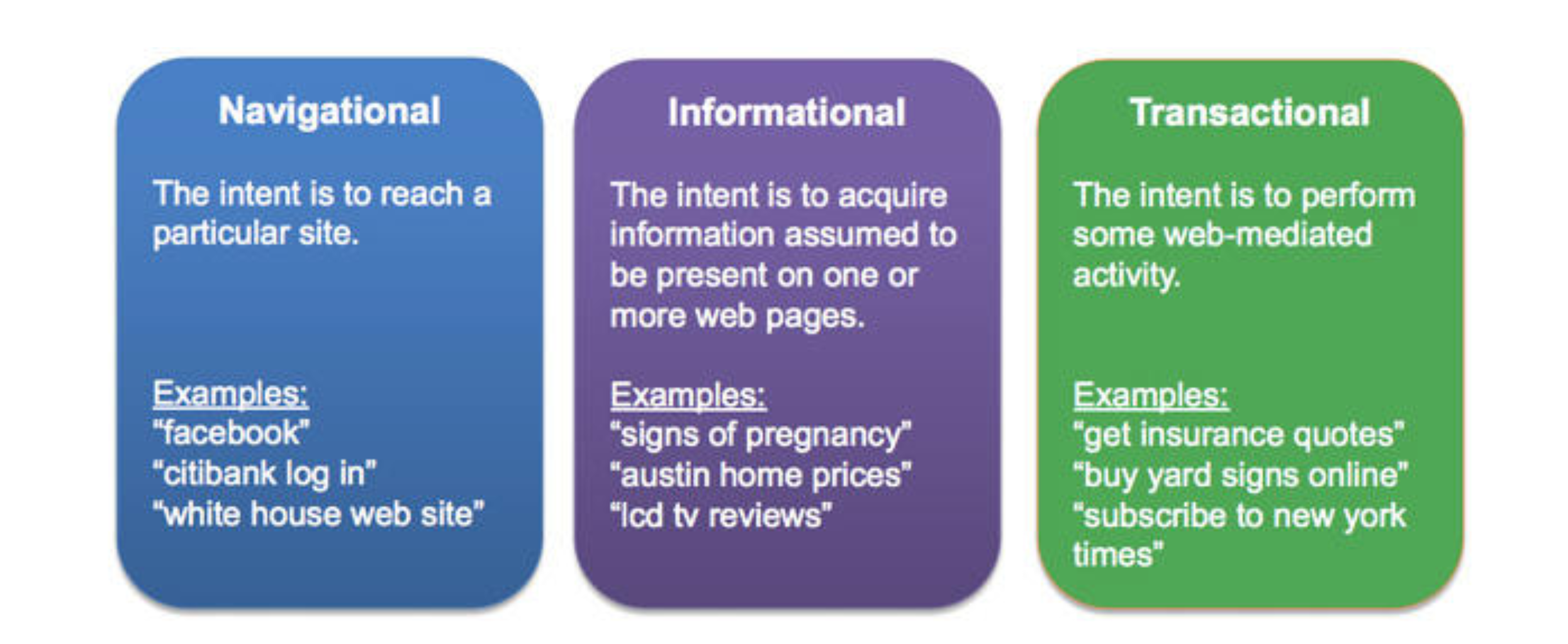
From the examples above, navigational keywords apply mainly to big brands and household names. People searching for these keywords are fully aware of the brand, but they don’t know the website URL.
For most website owners, however, the focus is on finding informational and transactional keywords. Optimizing for these keywords allows them to create useful content that helps build trust among their audience (informational), which they can leverage into conversions later on (commercial).
The clear distinction between informational and transactional content is that the former merely educates your audience while the latter allows you to profit from them.
Back then, since the purpose of building a website was to monetize it, searching primarily for commercial keywords made sense. You want to rank for keywords that people search for when they’re ready to make a purchase. From here, you can generate more product sales and affiliate commissions.
However, with topic relevance in effect, it’s impossible to rank a website that consists of pages optimized for commercial keywords.
In particular, Google’s product reviews update targeted affiliate websites that contain pages with content optimize for transactional keywords. In essence, sites with content optimized for the following keywords below are devalued by Google’s update:
- ● Product reviews ([name of product] review)
- ● Comparison posts ([product 1] vs. [product 2])
● Round-up posts (best [product type])
The logic behind devaluing sites with most content targeting commercial keywords is that they don’t add value to their audience. While their reviews may be well-written, the fact that they don’t have informational content shows to Google that they’re merely interested in profiting off their website and not provide their target audience with the best information about a topic.
There are lots of websites that fell victim to the product reviews update. One of the more famous examples is GearHungry.com:
The site’s organic traffic started its sharp drop at the start of 2021 and continued its downward spiral up to April 9, 2021, a day before Google released its blog post about the product reviews update.
The update forced the hand of site owners to create more informational content, which is in line with the onus put on topical relevance as a ranking factor.
Therefore, the question now is: what’s the ideal informational to commercial content ratio on your site?
There are no documented figures regarding the number of informational content vis-a-vis commercial content. However, Byron Brewer of Human Proof Designs says that he has 50-70% informational content on his affiliate sites.
The percentage suggests that you need to create fewer commercial content and more informational content. And while you won’t make money from this content type, they nonetheless help keep your money pages afloat on SERPs and sustain your site for a long time.
Determining the keyword’s user intent is not very difficult, although it could be time-consuming if you’re not using a tool.
Commercial keywords are the simplest to find. As discussed earlier, examples of commercial content include product reviews, comparison posts, and the like. By adding modifiers like “review,” “best,” “vs.,” and others, you can brainstorm for keyword ideas that will help you profit from your site.
However, since you want your money pages to generate traffic on Google, you want to make sure that they have search volumes. This way, you can scale your efforts once they start ranking on Google and make the necessary improvements to help increase their positions on SERPs.
Using Ahrefs, click on Keyword Explorer and type in your site’s topic. On the next page, show all keyword ideas so you can see all of the potential commercial keywords you can use for your site.
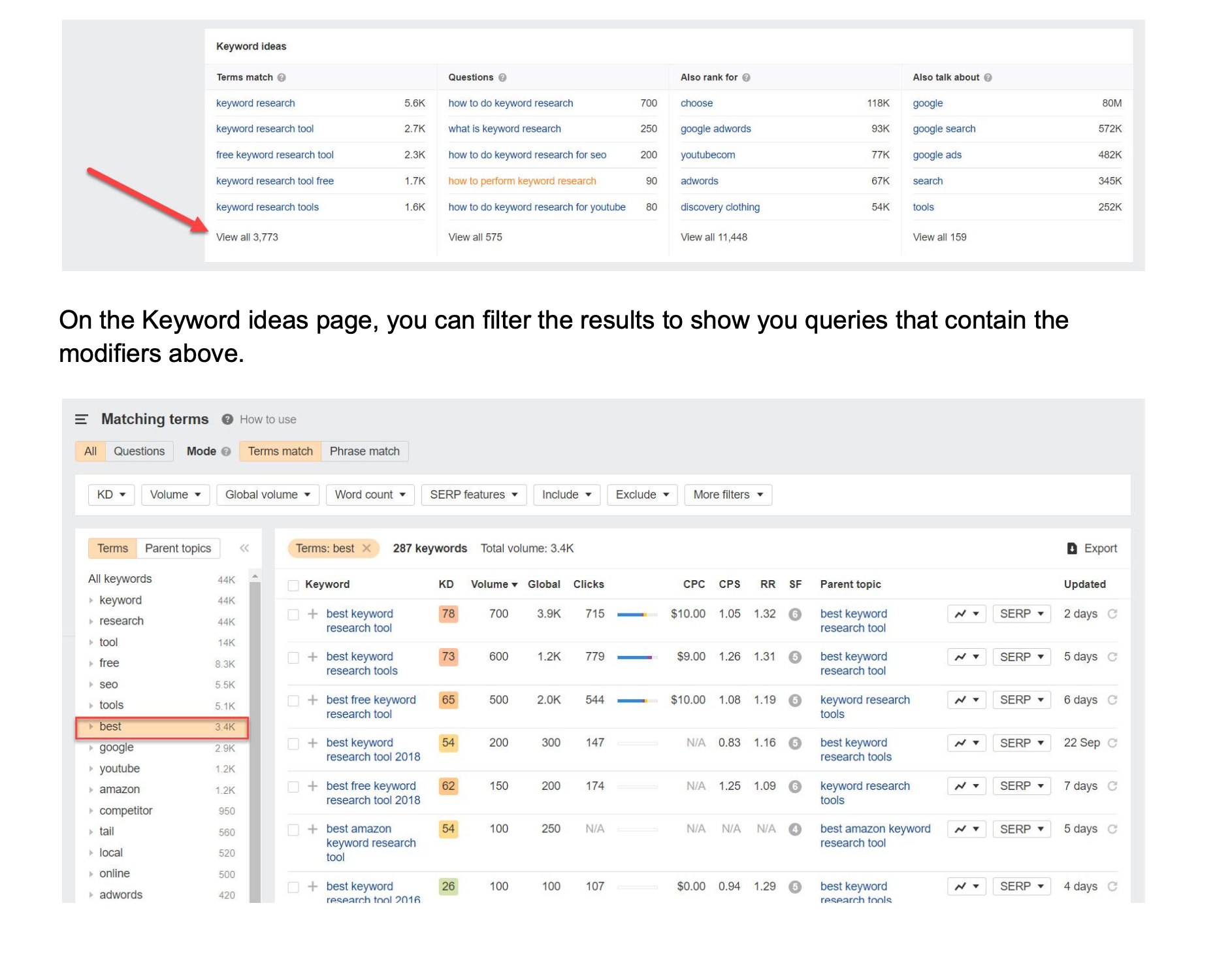
You can also see keyword metrics so you can narrow down your choice if necessary. Take these metrics as suggestions to help guide your research and not as full-proof data about the keywords.
From here, you should have a handful of commercial keywords that you can create content for your site.
The next thing you need to do is find informational keywords to complement your money pages.
From Ahrefs, you can see the questions tab on the keyword results. Click on that one to show you all the possible keywords you can optimize on your website about the topic.
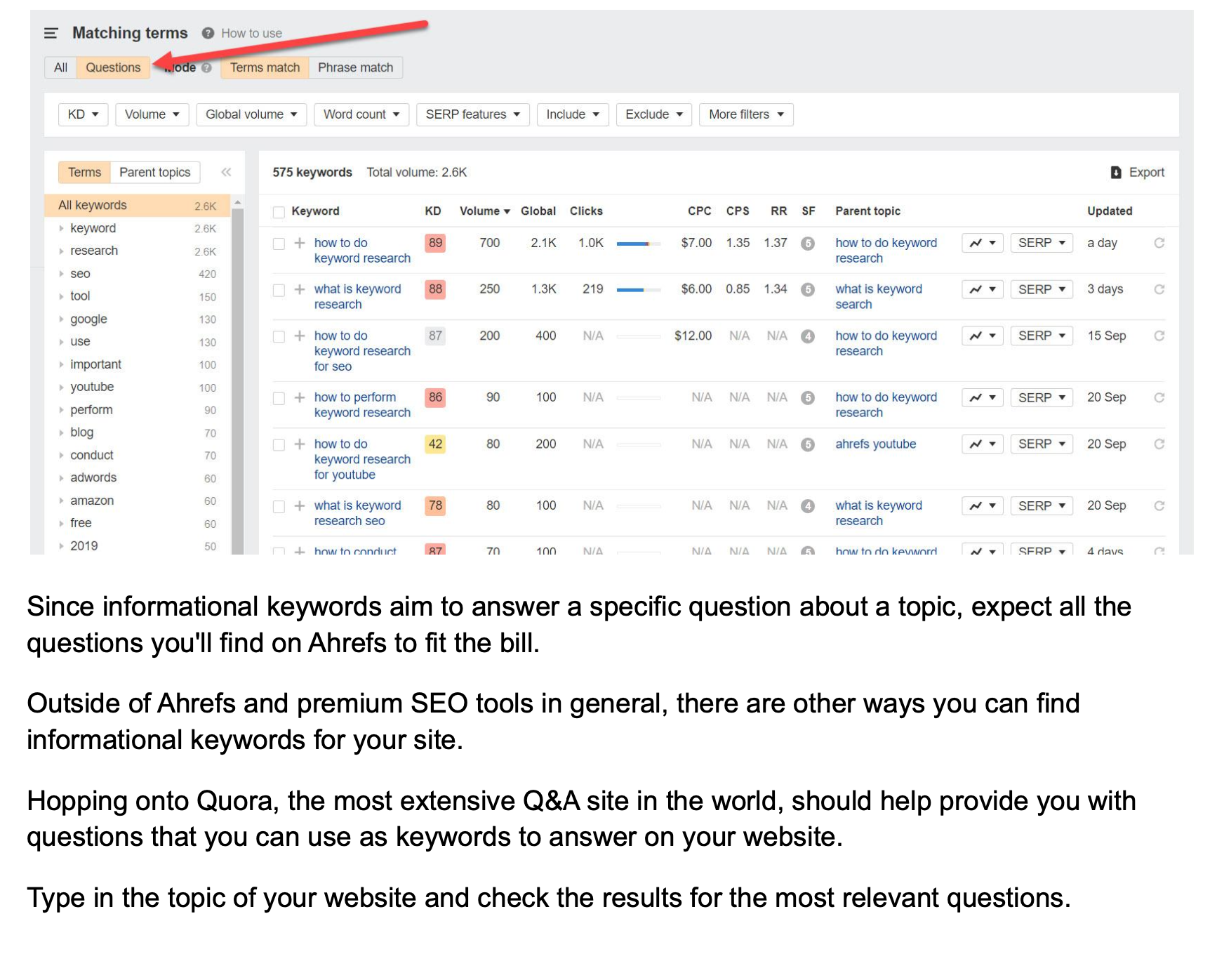
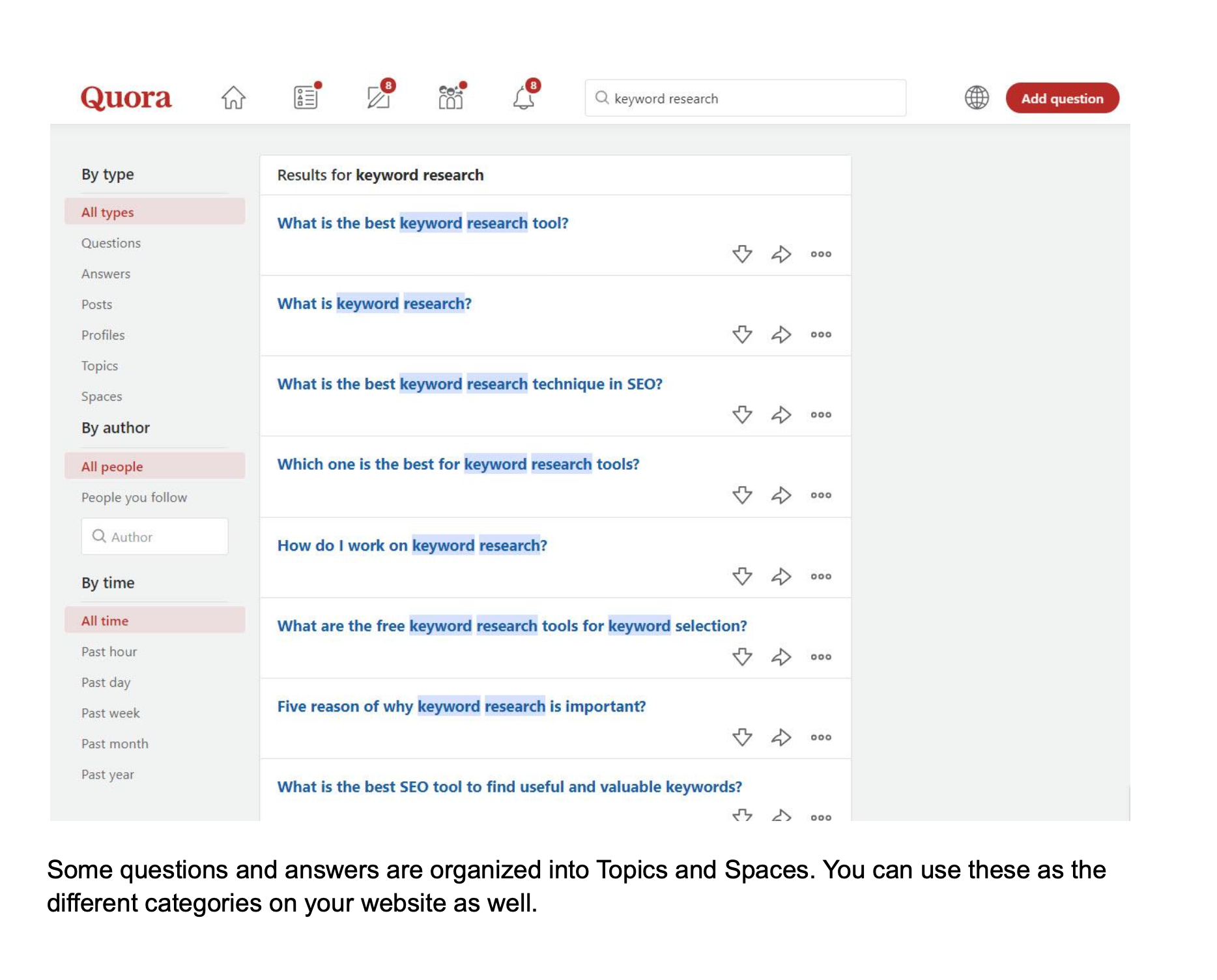
Another good thing about Quora is that most of the questions have answers as well. Not all of them are great by themselves, but you can combine the best solutions for a question and use them in the content you’ll write for it.
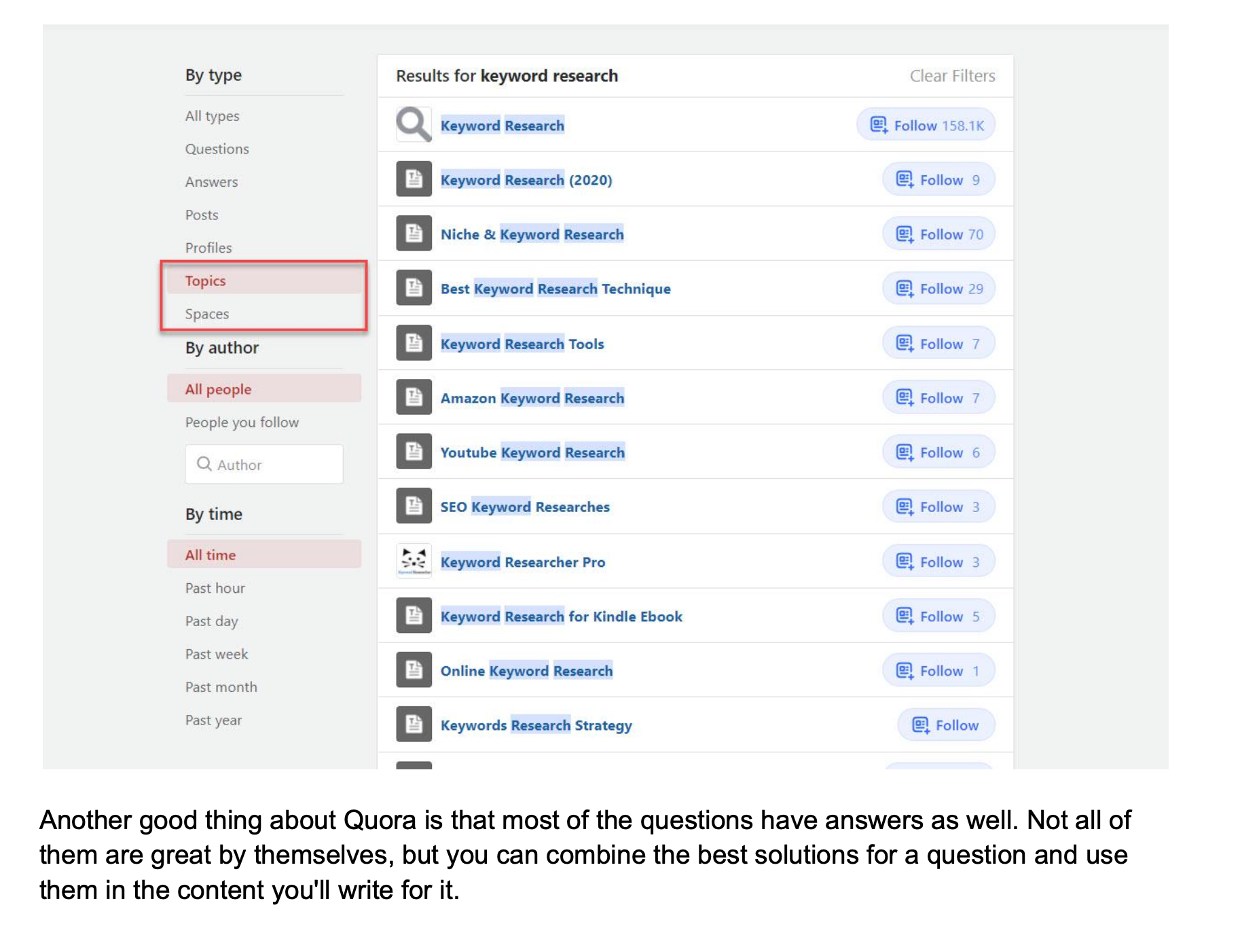
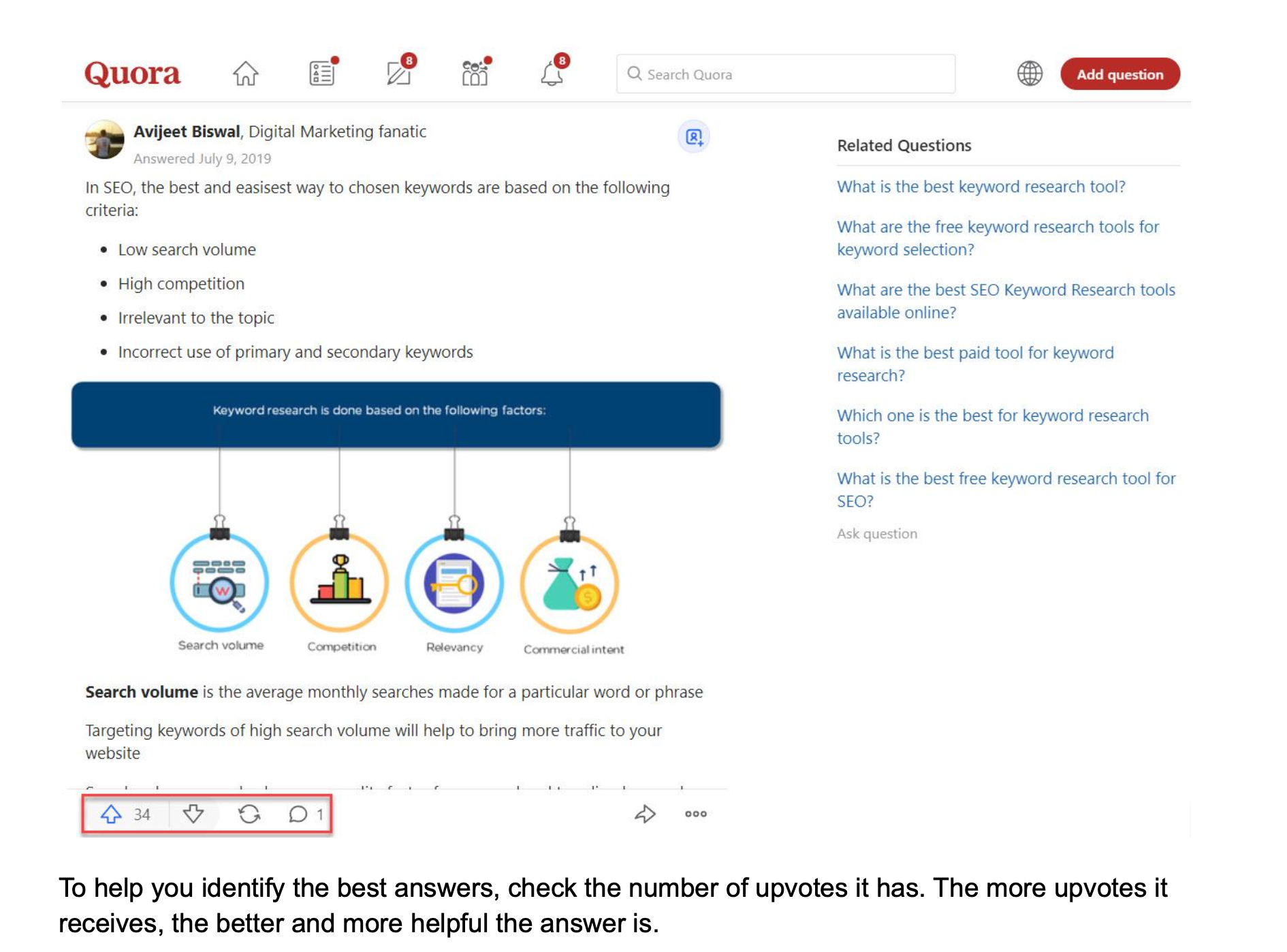
To help you identify the best answers, check the number of upvotes it has. The more upvotes it receives, the better and more helpful the answer is.
Another tool you can use to help you unearth informational long-tail keywords is Answer the Public. It’s a freemium keyword research tool that provides you with an exhaustive list of questions about the topic you entered.
Upon searching for your site’s topic, the next page shows you the different keywords organized into questions, prepositions, comparisons, and alphabeticals. You can even export the data in a visual format to help you make sense of things much better.
Create Content Silos
By researching keywords based on intent, you can beef up your website with the right mix of informational and commercial content that search engines will reward later down the line.
However, even if you’ve found the best keywords for your site with intent in mind, it won’t necessarily guarantee you increased rankings over time.
As mentioned, you need to make sense of the keywords you found to help boost your topic relevancy. While it’s true that all of the keywords are about the same theme or topic, how you structure them into your website is what matters in this case.
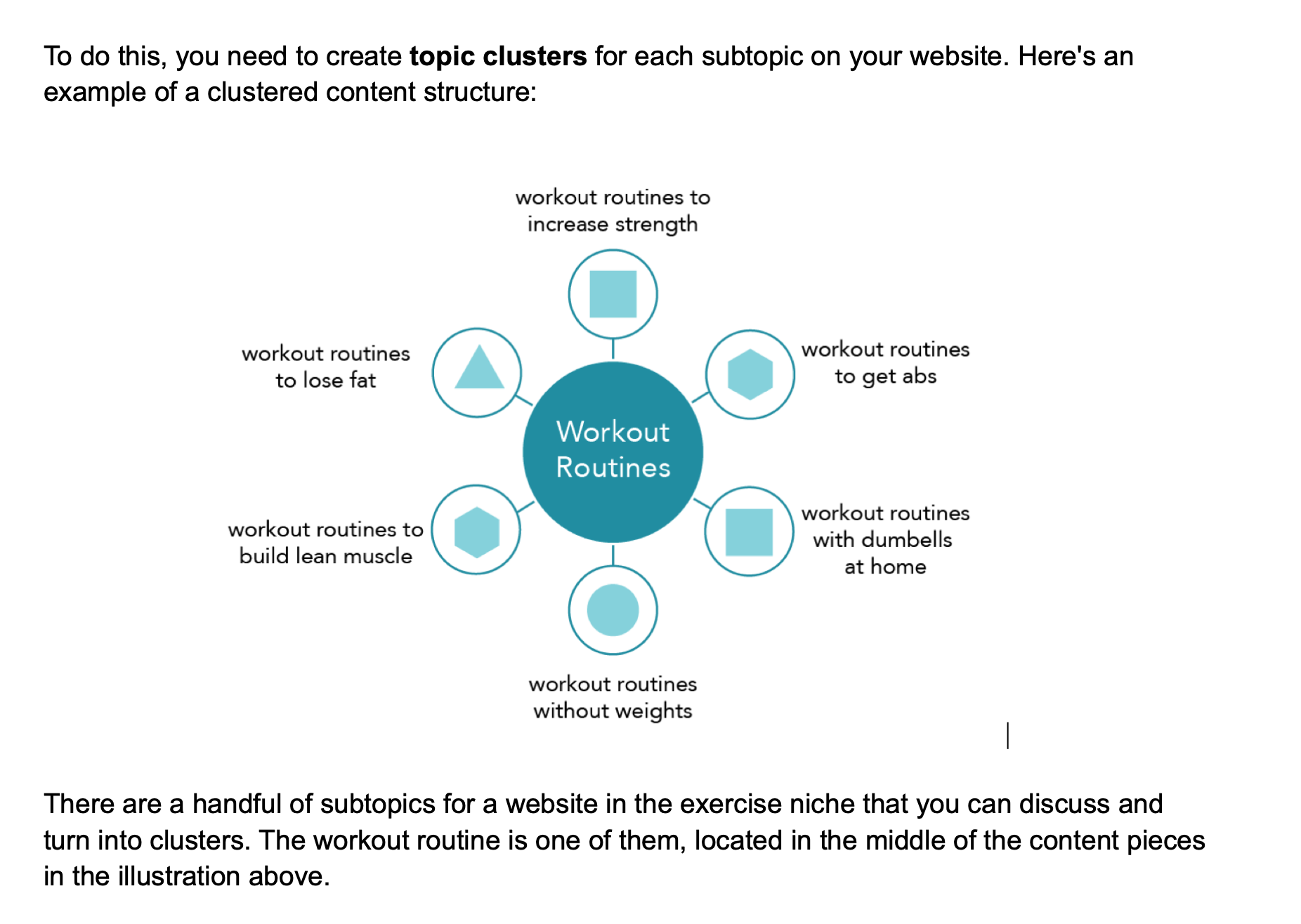
You can turn “workout routines” into a category that houses all related content on your site. However, it’s best to turn this subtopic into a piece of content that discusses the different workout routines people can do depending on their goals. For the sake of this discussion, let’s refer to this particular subtopic as your target page.
The other shapes surrounding the target page are supporting articles. They optimize for question keywords to provide more insights and context about the subtopic. For example, “working routines to get abs” falls under the working routine subtopic, but its user intent is to learn the specific exercises that will help people develop abdominal muscles.
Now, what turns these into a content silo are internal links. In the diagram above, all supporting articles link to the target page and vice versa. This is done to help users seamlessly navigate through the different related pages on your site. For example, your target page can serve as the content hub where people can find the links to all articles about the subtopic on your site.
More importantly, topic clusters help Google understand the relationship among the related pages on your websites. By linking them to one another, you’re telling search spiders that these content pieces share a common theme. And once Google identifies the context of all the articles in a topic cluster using its NLP methodology, it can help increase your site’s topic relevance as a result.
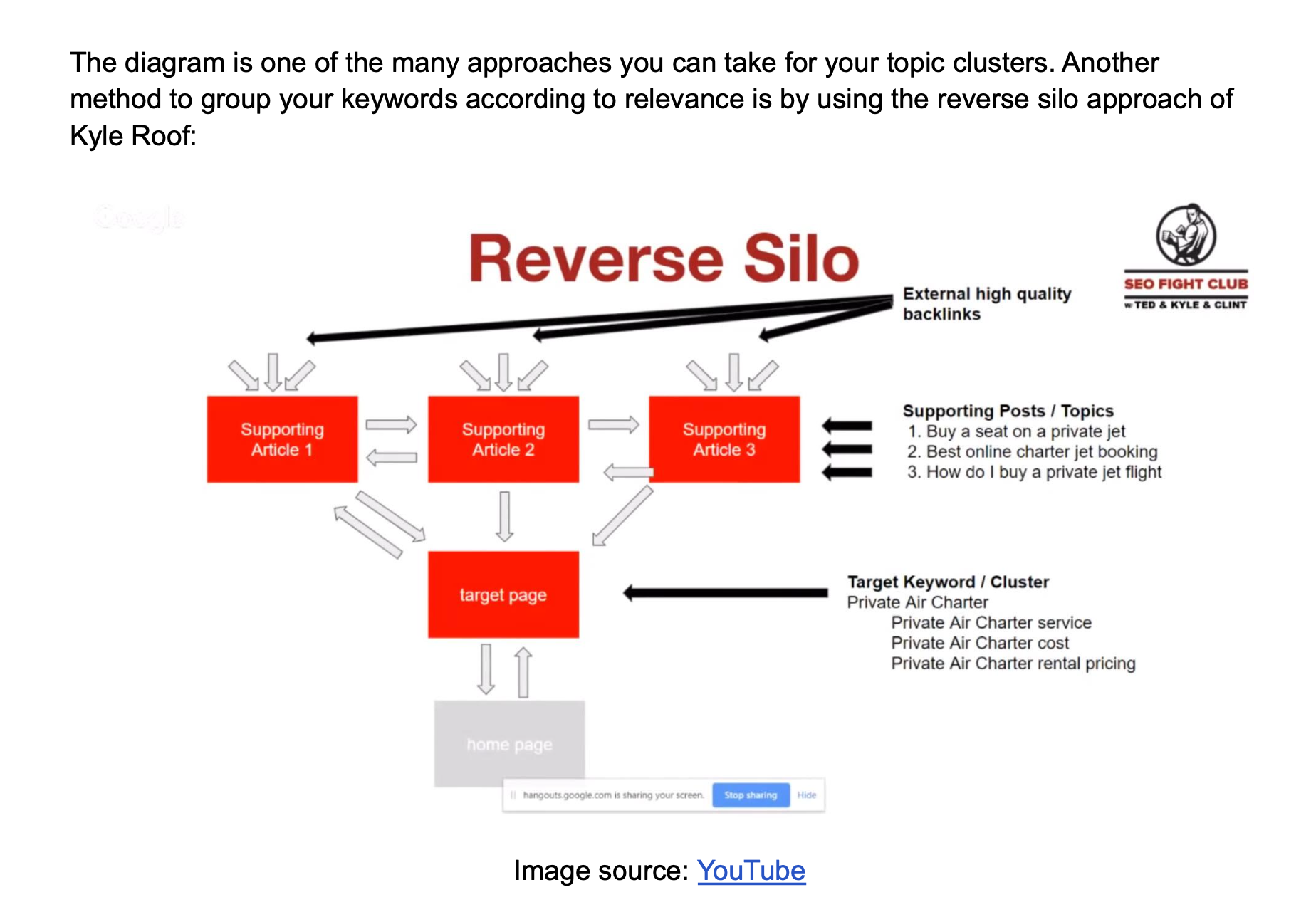
The principle here is the same: you want to interlink related pages to help Google determine
your site’s topic relevance. However, the difference is how the links flow from one another.
In the reverse silo structure, the supporting articles link with each other like a daisy chain, such as:
- ● Article 1 links to article 2
- ● Article 2 links to articles 1 and 3
- ● Article 3 links to article 2
- ● Articles 1 and 3 don’t link to each otherAll supporting articles link back to the target page. However, the target page only links back to one supporting article. The purpose of doing this is to limit the link juice from escaping the target page, which is what you want to rank on Google in the first place.
Regardless of the approach you choose, you should be fine as long as you can present your content in a topically organized manner.
At this point, you should have found keywords for your site using the methods in the previous section. Your job now is to organize them in different clusters.
You can build the clusters manually by identifying the subtopics from the keywords you’ve researched and trace their respective long-tail keywords in your list. However, going the manual route may not be a feasible option if you have thousands of keywords in your list.
Thankfully, there are tools you can use to help you get the job done. Keyword Cupid is one such tool that you can use to clusters the keywords you’ve researched in minutes.
Aside from using tools, there is a much simpler way to build topic clusters for your site, and it involves using Google search.
On Google, simply search for your keyword on keyword. From the search result, scroll down the page to find the People Also Ask section, where you can find relevant questions about your query:
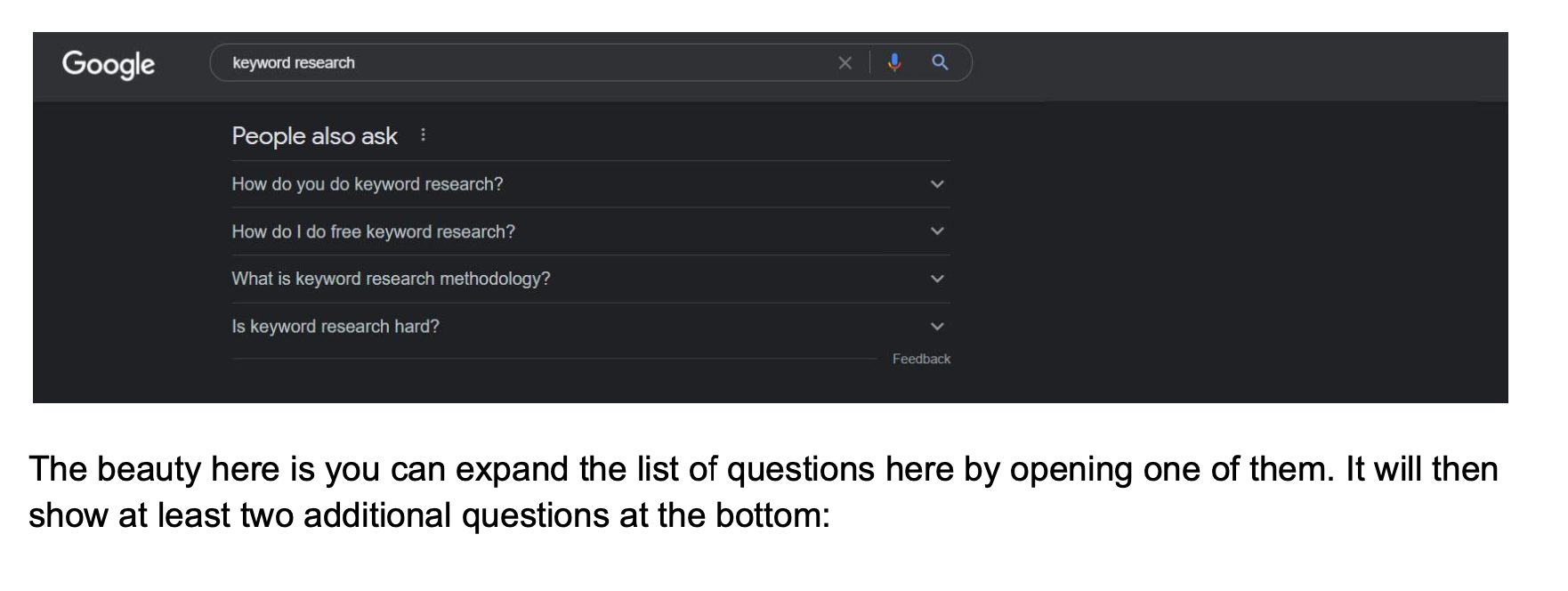
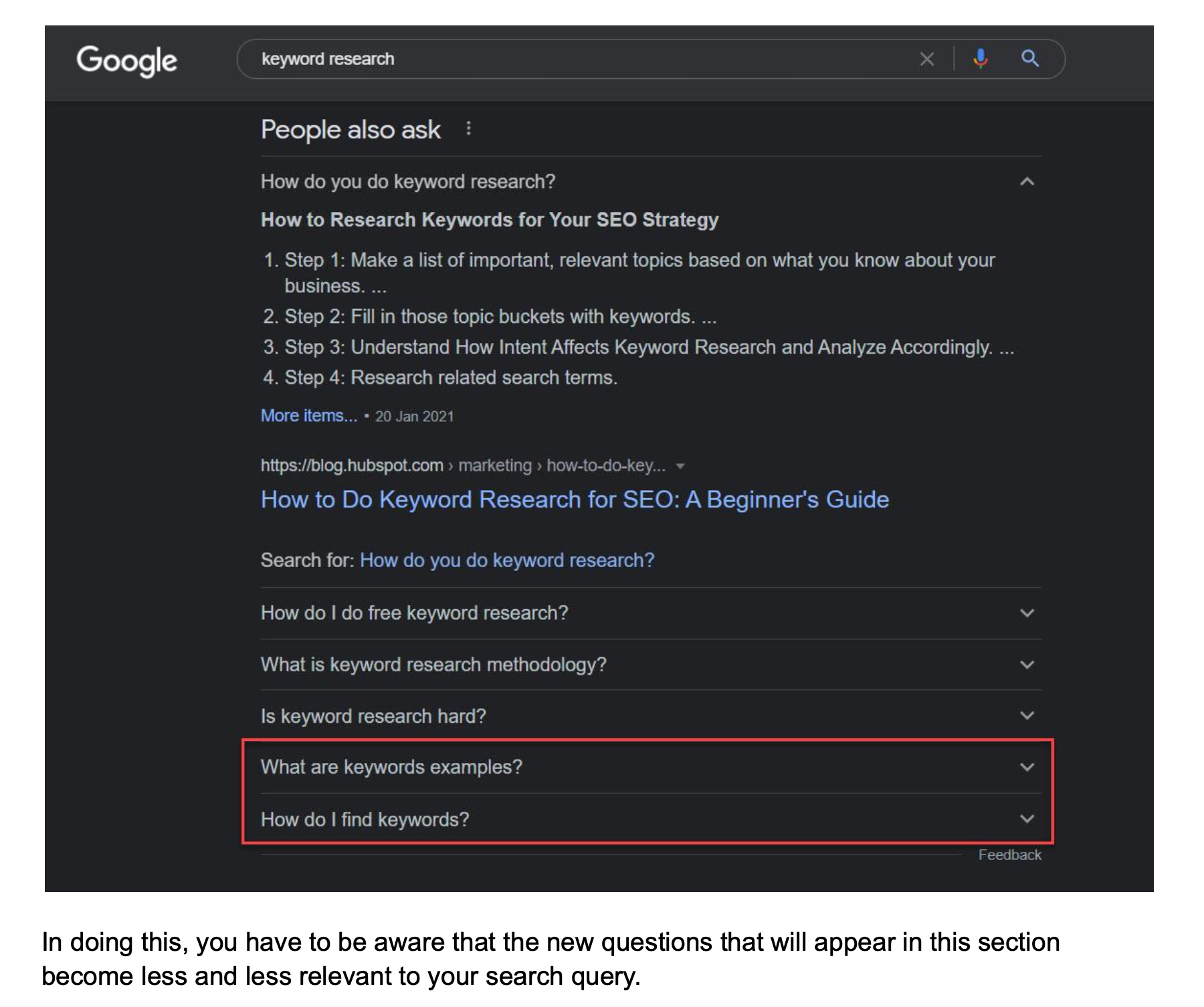
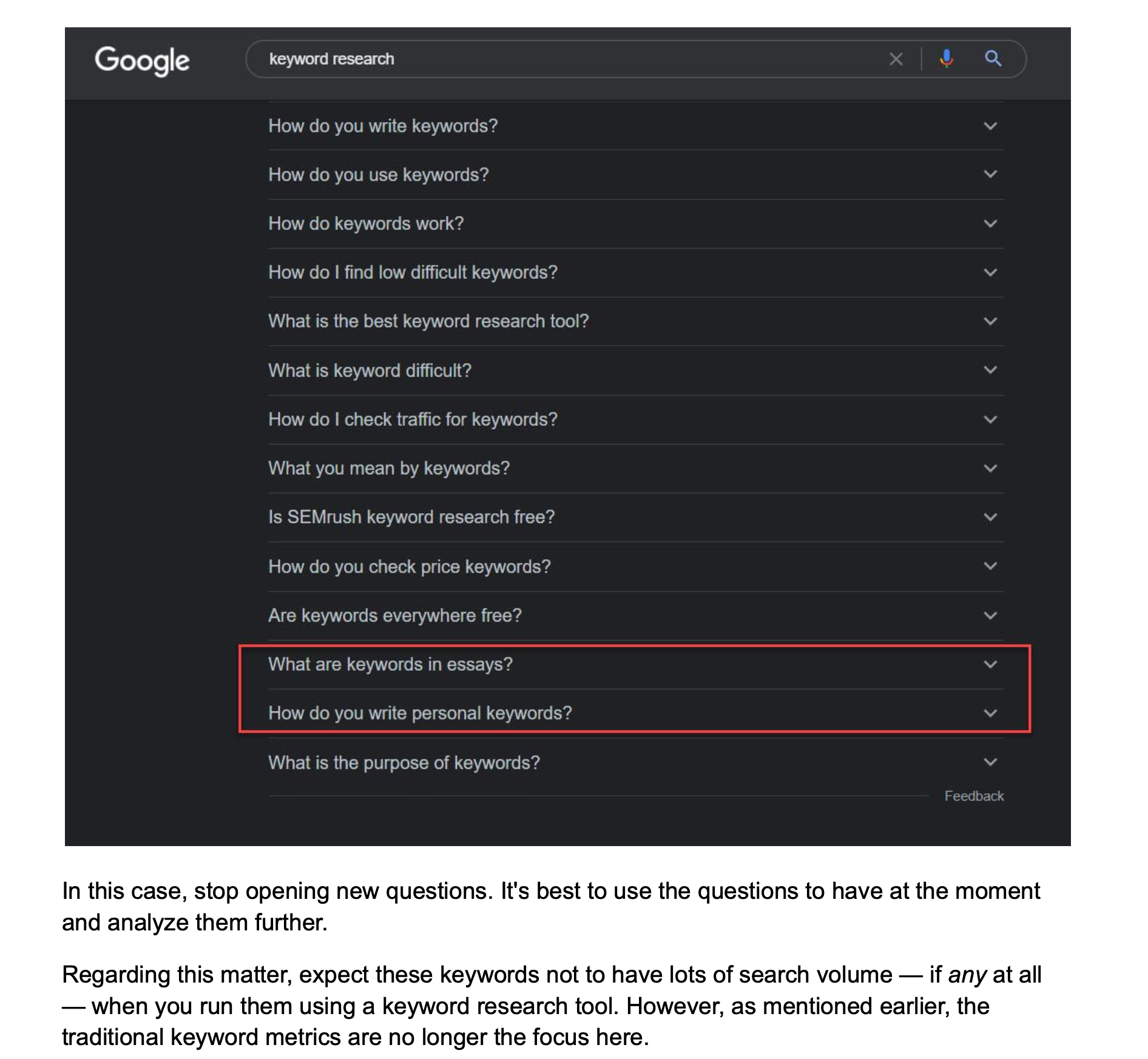
The fact that these questions appeared on Google for the keyword you typed means there is a strong correlation between each of them with your seed keyword. Therefore, you need to create informational content optimized for these questions to increase your topic relevancy.
Optimize for Topics
When you already have pages ranking on Google, there’s a good chance that those pages are also ranking for other keywords aside from your target keyword.
SEO tools allow you to see which keyword a page ranks for by entering the URL of the page your want to analyze.
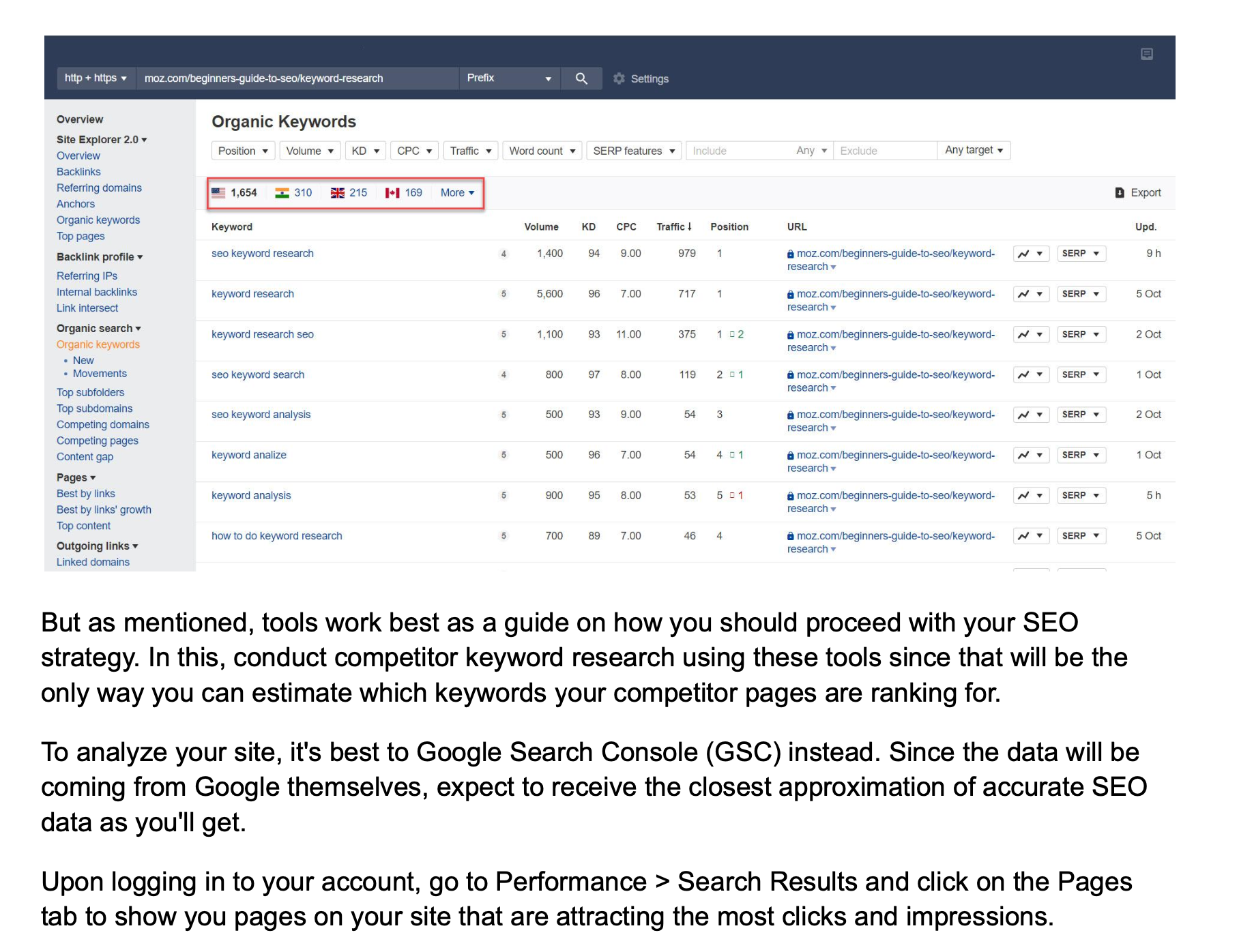
From here, it’s also possible that your page is ranking higher for keywords you weren’t targeting in the first place compared to your target keyword!
This shows you that Google does look into the context of your content and determine which among the queries you should rank for. From here, it can decide other keywords that the content should appear in on SERPs.
Optimizing for topics work best for existing content. Since the content has proven itself to rank for multiple keywords, all it takes now is a nudge in the right direction to help it improve its traffic even more.
Once you have the keywords from Google Search Console, export them to a spreadsheet. You’ll want to re-optimize the page not just for a keyword but for all.
To help you optimize your content for multiple keywords, use Surfer SEO’s Content Editor tool. You can enter up to 20 keywords for each editor. If Google Search Console found more than 20 keywords, just take the top 20 and paste them onto the text bar. Next, click on “Create Content Editor for x Keywords.
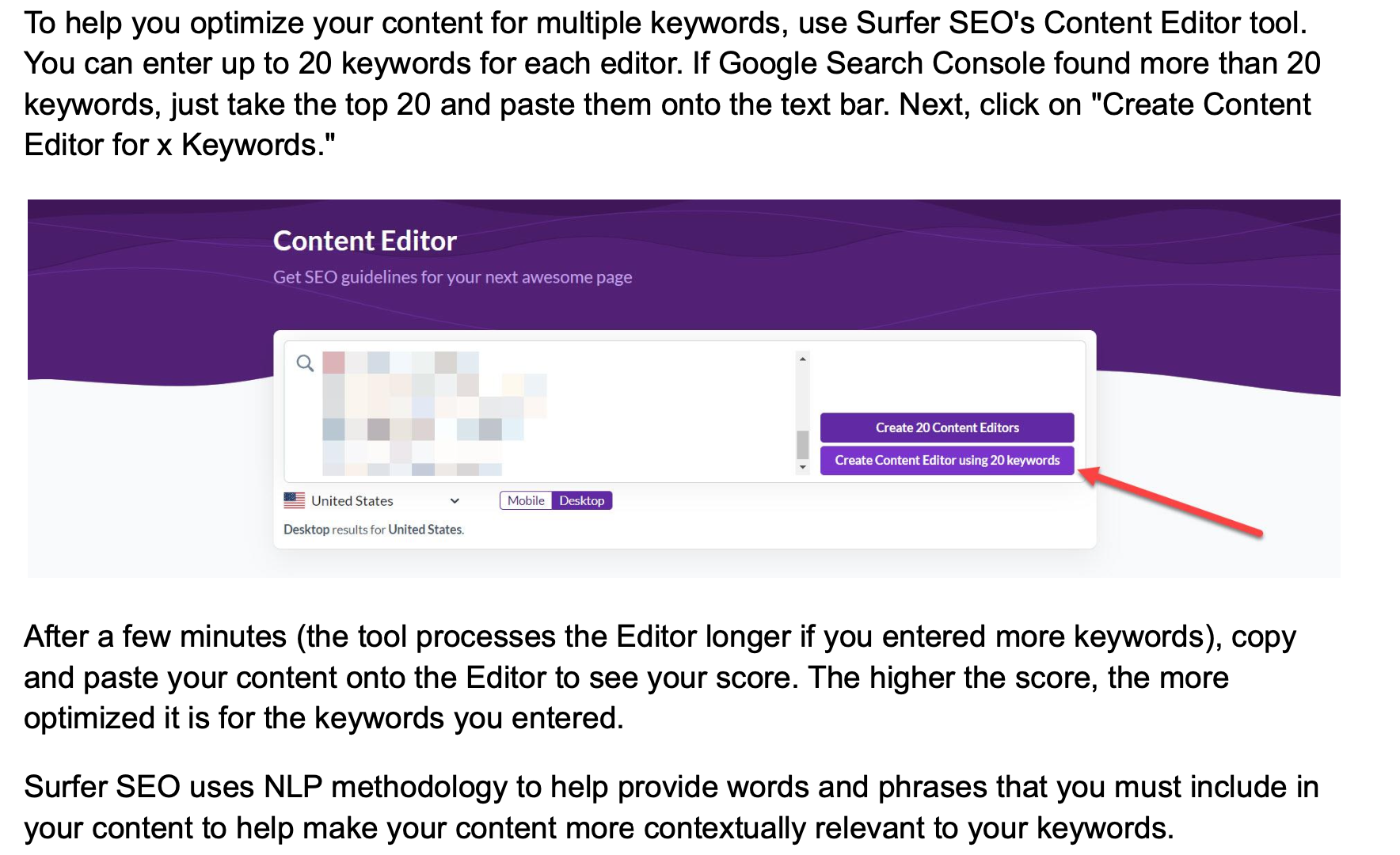
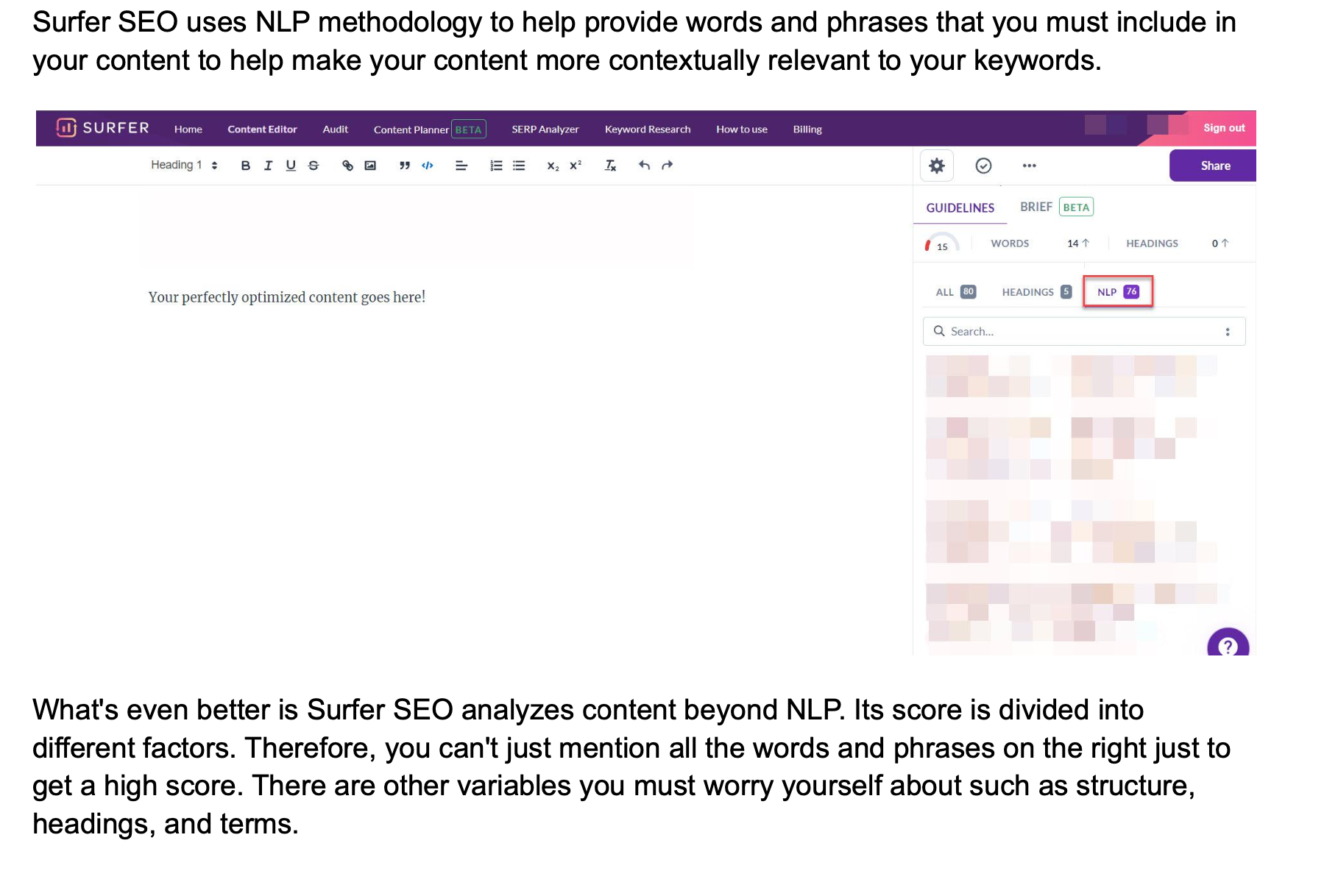
Again, Surfer SEO’s score isn’t reflective of how Google ranks its pages. Just because you have a high Content Score doesn’t automatically mean your page will rank on top of search engines for the keywords you included in your optimization process.
At the very least, tools like this point you to where you should be going if you want to rank on Google with your website.
Another great thing about Surfer SEO is it can research and cluster the keywords for you. To do this, click on the Content Planner and enter your site’s topic.
On the next page, you will all the best-performing articles on your site after connecting the software with Google Search Console. Then click on the Low Hanging Fruit filter to narrow down your site pages that aren’t ranking high on SERPs.
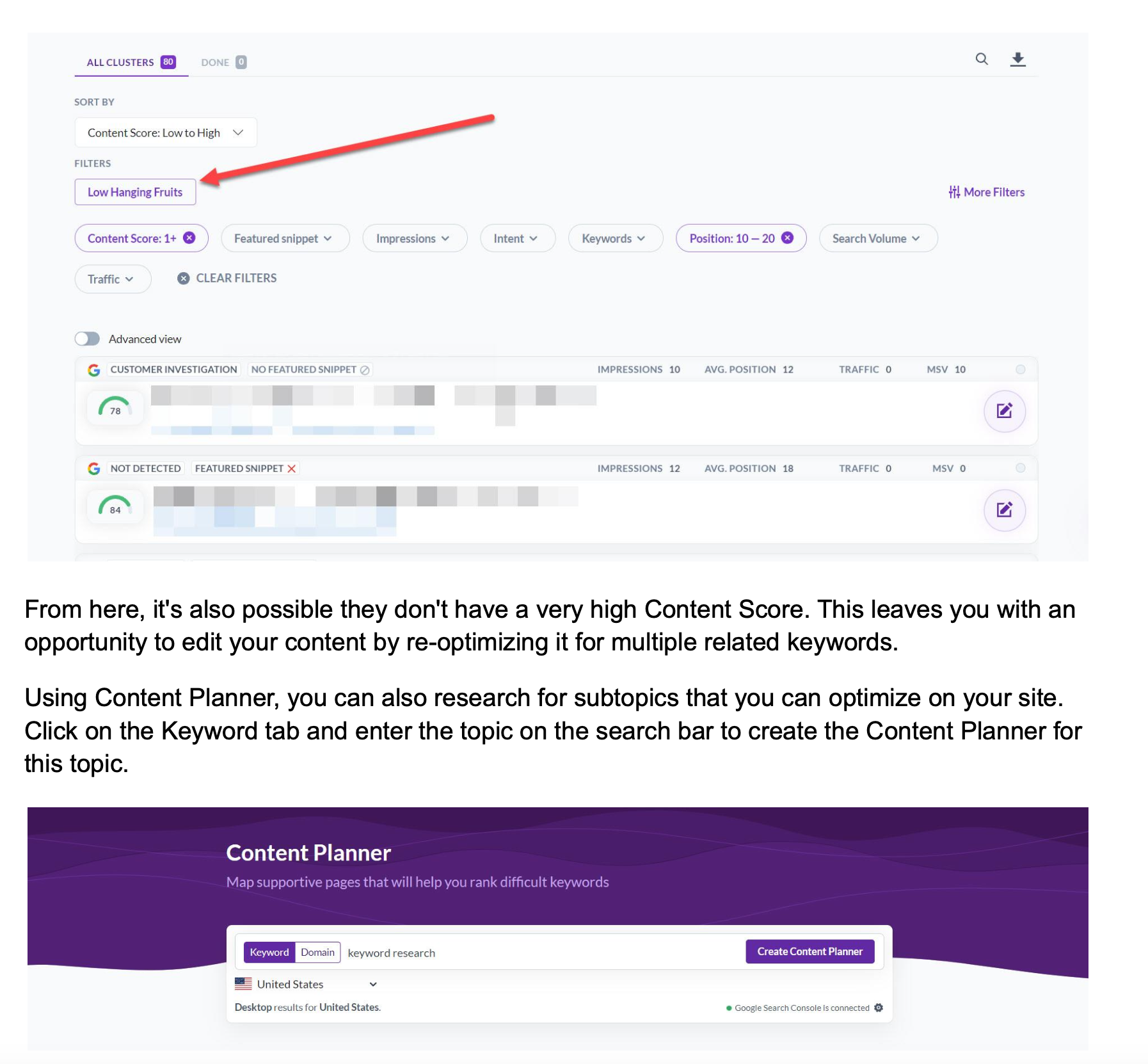
On the next page, you can filter the keywords according to user intent, the number of keywords clustered into a group, and search volume.
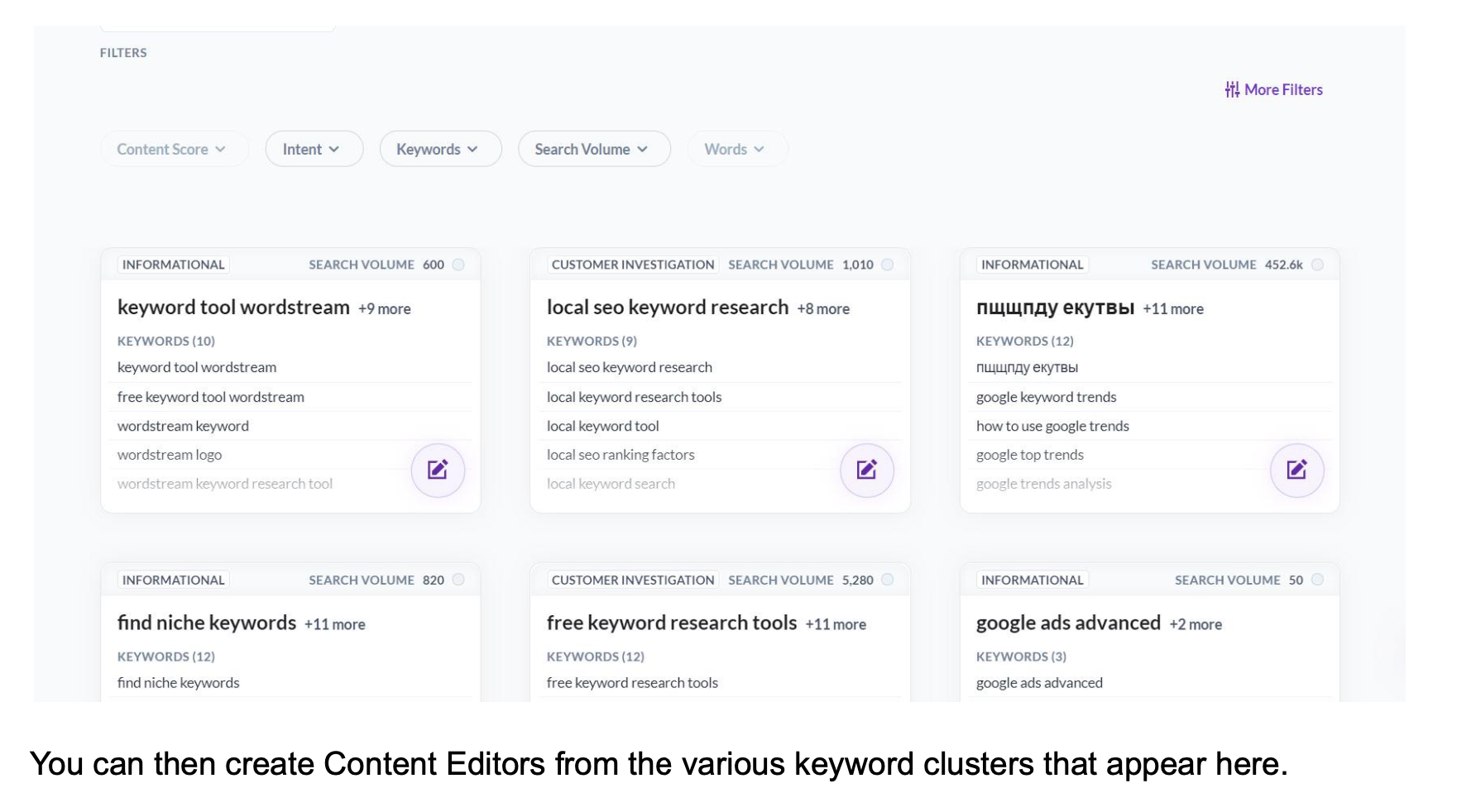
Modern Keyword Research Theories in Action
The approach to modern keyword research has opened the gates for SEOs to brainstorm new practices to help their sites become topically relevant. By finding keywords that will benefit your website as a whole instead of page by page, you can increase and sustain its rankings for a long time.
To help you make even more sense of the approach, below are some working theories and concepts that apply modern keyword research practices as their foundations.
Zero Search Volume (ZSV) Keywords
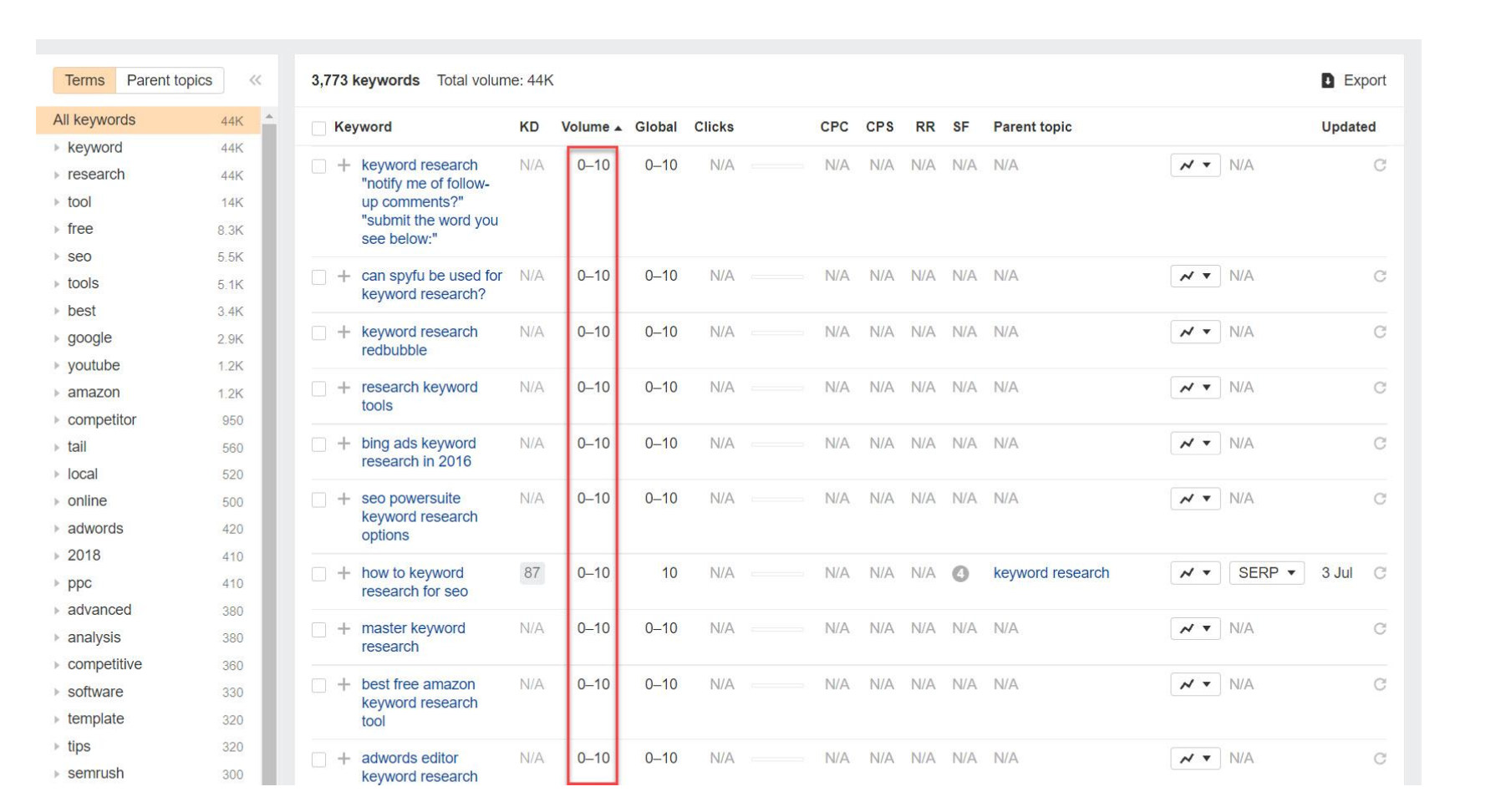
Traditionally, you don’t want to optimize for these keywords because the results from ranking on top for these keywords are not equivalent to the effort you have to create the content. Even if you’re ranking for these terms at the top of search results, you won’t get organic traffic from them because people aren’t searching for them. At least, that’s what your research is telling you.
However, ZSV keywords aren’t zero searches in the truest sense of the word. That means your page shouldn’t be getting clicks and impressions from Google Search Console.
To know for sure, you need to install the Keywords Everywhere Chrome extension and purchase credits to view the search volume of queries directly from GSC.
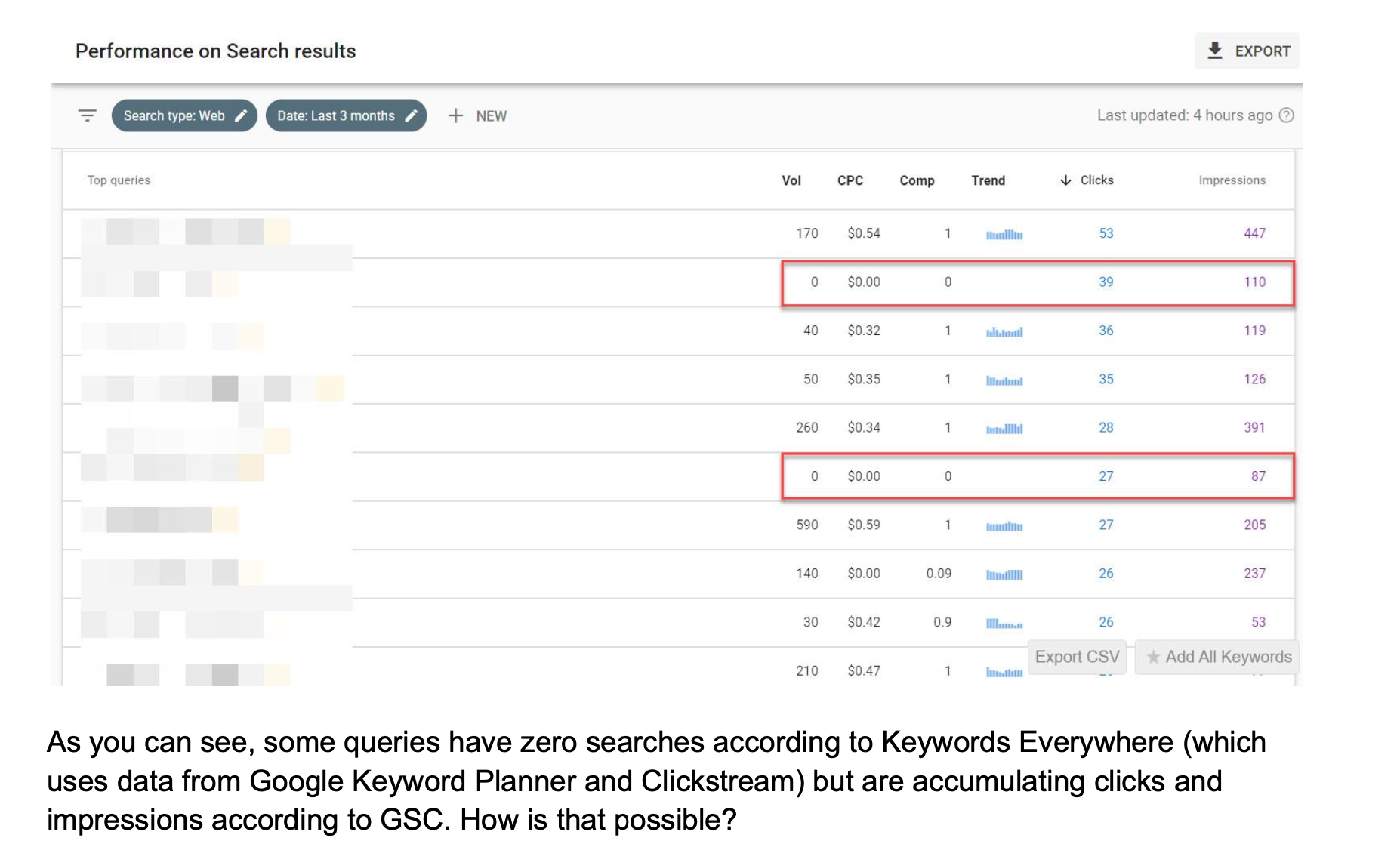
First, all tools are best used as guidelines to help you make the right decisions for your SEO campaigns. And since Keywords Everywhere takes data from Google Keyword Planner, you could assume that Google isn’t updating their database either. However, to put things into context, Google is more interested in producing the best possible search results to users while maintaining their keyword database for the benefit of SEO folks isn’t probably at the top of the list.
As a result, there’s not a lot of concrete information to work with regarding ZSV keywords. The only fact we know now is that just because the keyword has zero searches doesn’t mean people aren’t searching for it.
Nonetheless, finding out which ZSV keywords to target will be vital in your keyword research process. As shown above, you can identify what these keywords are from GSC with the help of Keywords Everywhere. However, it would be better to unearth these ZSV keywords before creating content for them. This way, you can fill the gaps in your keyword research that most people will miss in theirs.
Since there’s no data for these keywords, you need to look outside of SEO to find answers as to which among ZSV keywords you should optimize for in your content.
First, check if these keywords appear on discussion boards and forums in their niche. You can also check Quora and other Q&A sites if these keywords or their variations are asked. The fact that people talk about these topics and ask these questions means that there is interest in them. At the very least, that should validate that these ZSV keywords carry some weight.
To help you automatically collect threads and question posts for these keywords, you can use social listening tools like Awario. Just type in the keyword and identify the sources where you want the tool to search for. You can even include social media as part of your sources to expand your search.
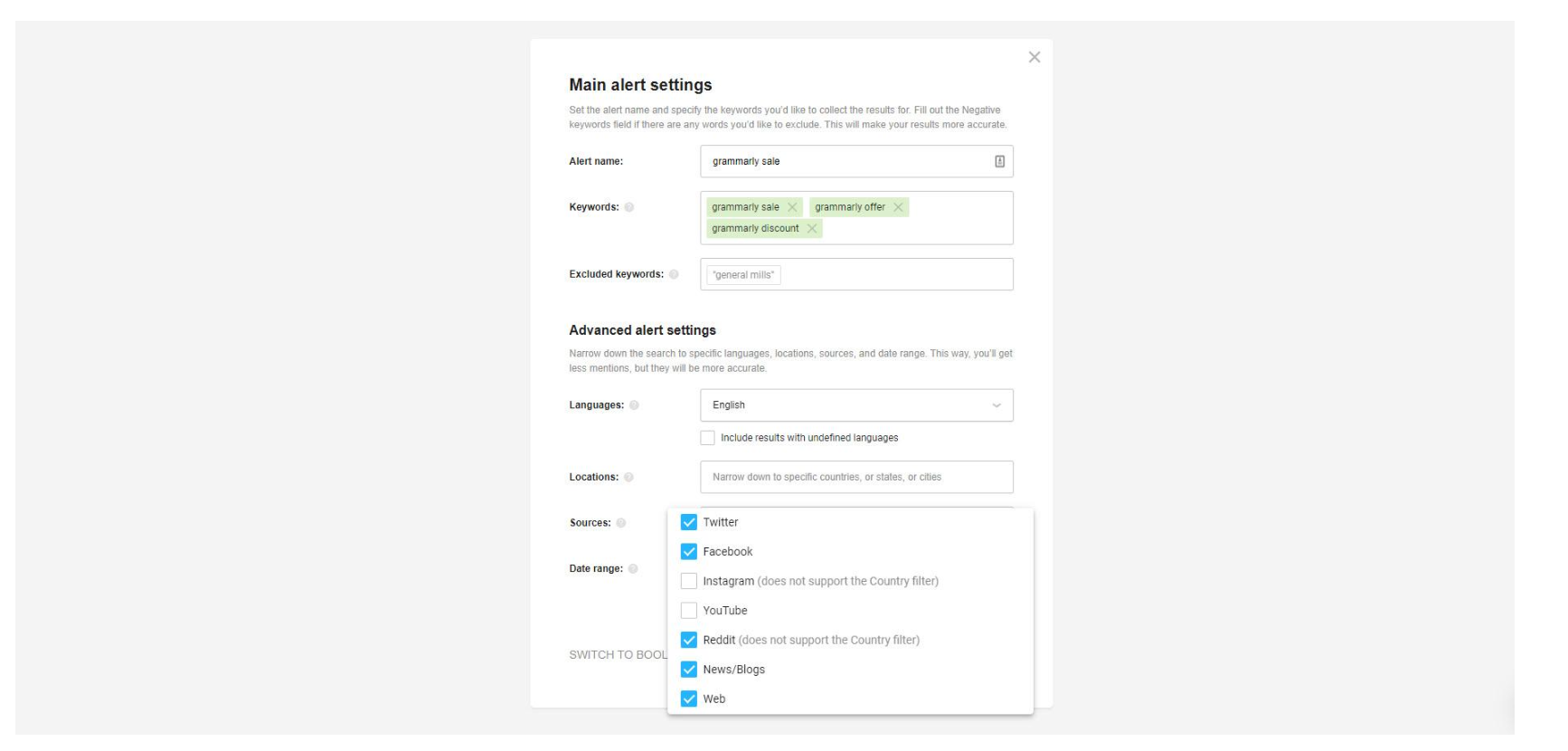
Another method you can use is by launching a paid ads campaign. That means you have to create a landing page and spend money to put up the ad on SERPs. However, within a few days and weeks, you should be able to gather information about the search query you bid for from actual people. From here, you can determine whether to optimize these ZSV keywords in your content.
Finally, you can ask your audience questions they want you as an expert to answer.
This is only possible if you have a mailing list and can directly ask them for questions. You can also use them to validate the ZSV keywords you’ve researched and determine which among them you should optimize for on your site.
If you don’t have a list, at least consistent traffic to your website should do. Embed surveys asking people to choose which among the topics they want to know the answers from you. Or you can encourage them to send their questions via contact form.
While these ideas may be rough around the edges, these may currently be the only ways to circumvent the ZSV keyword issue. Unless there’s a way to make sense of these keywords generating clicks and impressions on GSC, you need to think outside the SEO box to come up with solutions similar to the ones above.
However, one thing is very telling about Google regarding ZSV keywords:
gathering insights from your audience is becoming a more significant part of the keyword research process.
If you want to rank on Google, you must provide valuable content that your audience would want to read. This means looking outside the usual keyword metrics to determine which search queries to optimize for. Because search volume, KD, and others are readily available and your competitors already have information about them, you need to come up with other ways for researching keywords that your competitors don’t know of. And validating ZSV keywords with help from actual people may be the missing piece in the puzzle.
It will be interesting how information about this keyword type will unfold over time. In the meantime, your ability to unearth which ZSV keywords to hit on your website using the methods above could yield results to your site’s SEO performance that your competitors won’t be able to match.
SEO Avalanche
CCarter coined “SEO Avalanche” over at Builder Society. You can read more about it here. In a nutshell, the SEO Avalanche technique refers to the process of creating content by
targeting keywords according to your site’s “traffic tier.”
